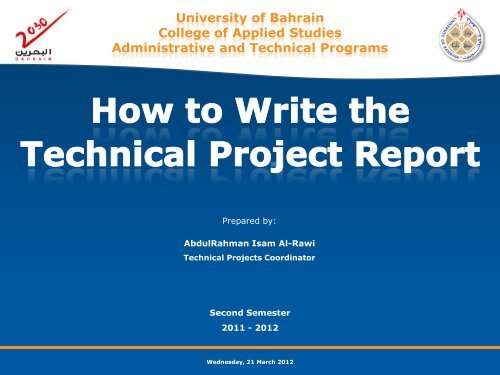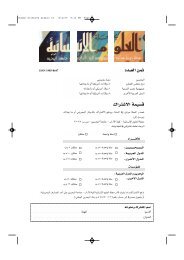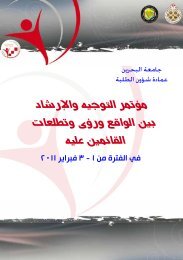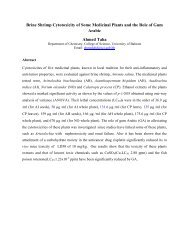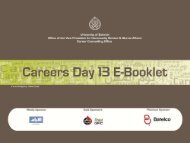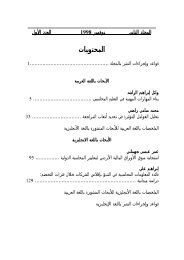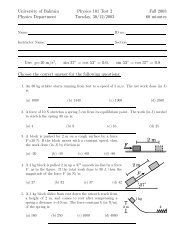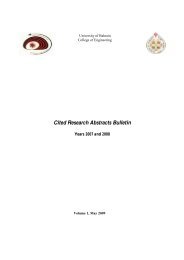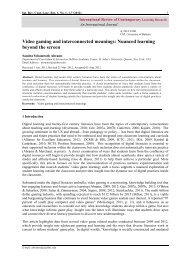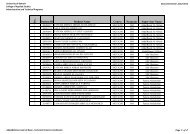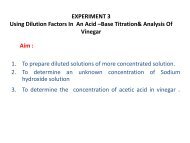Contents of the Project's Report
Contents of the Project's Report
Contents of the Project's Report
Create successful ePaper yourself
Turn your PDF publications into a flip-book with our unique Google optimized e-Paper software.
University <strong>of</strong> Bahrain<br />
College <strong>of</strong> Applied Studies<br />
Administrative and Technical Programs<br />
Prepared by:<br />
AbdulRahman Isam Al-Rawi<br />
Technical Projects Coordinator<br />
Second Semester<br />
2011 - 2012<br />
Wednesday, 21 March 2012
ALWAYS<br />
Trust Yourself<br />
كن واثقا<br />
بنفسك دائما
Important Notes<br />
The Technical Project mark distribution is as follows:<br />
‣ Practical Part: 50%.<br />
‣ Project’s <strong>Report</strong> 30%.<br />
‣ Project’s Presentation 20%.<br />
How to Write <strong>the</strong> Technical Project <strong>Report</strong><br />
21 March 2012
Important Notes<br />
Your <strong>Report</strong> will be evaluated based on <strong>the</strong> following factors<br />
‣ Completeness 10%.<br />
‣ Organization and Formatting 10%.<br />
‣ Citation and References 10%.<br />
How to Write <strong>the</strong> Technical Project <strong>Report</strong><br />
21 March 2012
Important Notes<br />
‣ Start writing your report early.<br />
‣ Plan for your report (project<br />
documentation) as you plan for <strong>the</strong><br />
practical part <strong>of</strong> <strong>the</strong> project.<br />
‣ Your report should not exceed<br />
15 pages.<br />
How to Write <strong>the</strong> Technical Project <strong>Report</strong><br />
21 March 2012
Important Notes<br />
‣ Consult your supervisor before and<br />
after writing each part <strong>of</strong> <strong>the</strong> report.<br />
‣ Give your supervisor enough time to<br />
read and revise it.<br />
‣ The submitted report should be<br />
bounded as spiral or as a s<strong>of</strong>t/hard<br />
cover.<br />
‣ <strong>Report</strong> bounded as stapled pages is<br />
not accepted.<br />
How to Write <strong>the</strong> Technical Project <strong>Report</strong><br />
21 March 2012
COMPLETE<br />
Your Work to<br />
<strong>the</strong> End<br />
أنجز عمهك<br />
حتى اننهاية
<strong>Report</strong> Submission deadline<br />
‣ Sunday, May 27, 2012 is <strong>the</strong> deadline for submitting your report.<br />
You will be penalized by (-1) mark for each working day <strong>of</strong> delay.<br />
‣ Submit FOUR copies <strong>of</strong> <strong>the</strong> project’s report to your supervisor.<br />
How to Write <strong>the</strong> Technical Project <strong>Report</strong><br />
21 March 2012
<strong>Report</strong> Page Formatting<br />
‣ Use regular white A4 paper.<br />
‣ All pages are single sided.<br />
‣ Paper margins should be about:<br />
• Top: 2.54 cm<br />
• Bottom: 2.54 cm<br />
• Left: 3.5 cm<br />
• Right: 2.54 cm<br />
‣ You can also use <strong>the</strong> default MS word<br />
margins.<br />
How to Write <strong>the</strong> Technical Project <strong>Report</strong><br />
21 March 2012
<strong>Report</strong> Page Numbering<br />
‣ Title page has NO number.<br />
‣ Numeric page numbering begins with <strong>the</strong> first page <strong>of</strong> Chapter 1.<br />
How to Write <strong>the</strong> Technical Project <strong>Report</strong><br />
21 March 2012
Paragraph Spacing & Justification<br />
‣ Justify <strong>the</strong> paragraph.<br />
‣ Text is 1.5-spaced, except for long<br />
quotations.<br />
‣ Skip a line between paragraphs.<br />
How to Write <strong>the</strong> Technical Project <strong>Report</strong><br />
21 March 2012
Font Type and Formatting<br />
‣ Use readable fonts.<br />
‣ It is preferable to use Serif fonts for<br />
body text.<br />
‣ Use font formats (bold, italic, or<br />
underline) only for a specific purpose.<br />
Sans Serif<br />
Sans Serif<br />
Sans Serif<br />
Serif<br />
Serif<br />
Serif<br />
How to Write <strong>the</strong> Technical Project <strong>Report</strong><br />
21 March 2012
Font Size<br />
‣ Font size for <strong>the</strong> body text should be<br />
12-14, and 16-18 for <strong>the</strong> headings.<br />
‣ Headings MUST be larger than subheading<br />
and body text.<br />
‣ Sub-headings MUST be larger than<br />
body text.<br />
Heading (title)<br />
Sub-heading (sub-title)<br />
Body text must be smaller than<br />
sub-headings and heading. Serif<br />
font is preferable for body text,<br />
while sans-serif is preferable for<br />
titles and sub-titles.<br />
How to Write <strong>the</strong> Technical Project <strong>Report</strong><br />
21 March 2012
ال تستسهم DON’T<br />
نهفشم أبدا Give in to Failure
<strong>Contents</strong> <strong>of</strong> <strong>the</strong> Project’s <strong>Report</strong><br />
1. Title page.<br />
2. Approved project proposal form.<br />
3. Acknowledgments.<br />
4. Abstract.<br />
5. Table <strong>of</strong> <strong>Contents</strong>.<br />
6. Chapter One: Introduction.<br />
7. Chapter Two: Theory Related to <strong>the</strong> Project.<br />
8. Chapter Three: Description <strong>of</strong> <strong>the</strong> Project.<br />
9. Chapter Four: Results and Analysis (optional).<br />
Except for Commercial Studies which is REQUIRED<br />
10. Chapter Five: Conclusion and Recommendation<br />
11. References.<br />
12. Appendices (optional).<br />
How to Write <strong>the</strong> Technical Project <strong>Report</strong><br />
21 March 2012
Title Page<br />
‣ All text on <strong>the</strong> title page is centered<br />
vertically and horizontally.<br />
‣ The title page has NO number.<br />
‣ The title page should include:<br />
1. University and College names.<br />
2. Project’s title.<br />
3. Student(s) name(s) and ID(s).<br />
4. Supervisor name.<br />
5. Date <strong>of</strong> submission.<br />
How to Write <strong>the</strong> Technical Project <strong>Report</strong><br />
21 March 2012
Approved Project Proposal Form<br />
‣ The attached proposal form must be<br />
signed by <strong>the</strong> students and <strong>the</strong>ir<br />
supervisor.<br />
How to Write <strong>the</strong> Technical Project <strong>Report</strong><br />
21 March 2012
Acknowledgments<br />
‣ Thank your supervisor and o<strong>the</strong>r<br />
individuals who have provided any<br />
assistance.<br />
How to Write <strong>the</strong> Technical Project <strong>Report</strong><br />
21 March 2012
Abstract<br />
‣ Write your abstract after <strong>the</strong> rest <strong>of</strong> <strong>the</strong> report is completed.<br />
‣ It tells <strong>the</strong> reader WHAT you did, WHY you did it, HOW you did it,<br />
WHAT you found, and WHAT it means.<br />
‣ Write only what is essential briefly, using no more words than<br />
necessary to convey meaning.<br />
How to Write <strong>the</strong> Technical Project <strong>Report</strong><br />
21 March 2012
Table <strong>of</strong> <strong>Contents</strong><br />
‣ It lists <strong>the</strong> main topics and subtopics <strong>of</strong><br />
your report as well as <strong>the</strong><br />
corresponding page numbers for each.<br />
‣ Items in <strong>the</strong> table <strong>of</strong> contents should<br />
be ordered by page number.<br />
‣ It is <strong>the</strong> last page that you will do.<br />
How to Write <strong>the</strong> Technical Project <strong>Report</strong><br />
21 March 2012
COMPLETE<br />
One Task<br />
at a Time<br />
قم بعمم واحد<br />
في وقت واحد
Chapter 1:<br />
Introduction<br />
‣ Start with a paragraph that introduces your topic to <strong>the</strong> reader.<br />
‣ Provide a clear summary <strong>of</strong> <strong>the</strong> project's background, relevance and<br />
main contributions.<br />
‣ Concentrate on <strong>the</strong> big issues, and avoid <strong>the</strong> temptation to list low<br />
level objectives.<br />
How to Write <strong>the</strong> Technical Project <strong>Report</strong><br />
21 March 2012
Chapter 2<br />
Theory Related to <strong>the</strong> Project<br />
‣ Write any related existing published<br />
work (research papers, articles, text<br />
books, technical manuals, or even<br />
existing s<strong>of</strong>tware or hardware) which<br />
you read at <strong>the</strong> start <strong>of</strong> <strong>the</strong> project<br />
when your approach and methods were<br />
being considered.<br />
How to Write <strong>the</strong> Technical Project <strong>Report</strong><br />
21 March 2012
Chapter 2<br />
Theory Related to <strong>the</strong> Project<br />
‣ You must acknowledge <strong>the</strong> sources <strong>of</strong><br />
your inspiration.<br />
‣ DO NOT Copy and Paste without<br />
citation!<br />
‣ Provide at least three different<br />
references from various sources.<br />
How to Write <strong>the</strong> Technical Project <strong>Report</strong><br />
21 March 2012
Chapter 3<br />
Description <strong>of</strong> <strong>the</strong> Project<br />
‣ Identify your project and explain its significance.<br />
‣ Discuss in detail <strong>the</strong> methods used to develop your project.<br />
How to Write <strong>the</strong> Technical Project <strong>Report</strong><br />
21 March 2012
Chapter 4<br />
Results and Analysis<br />
‣ Answer <strong>the</strong> questions “What did you find?” and “What do <strong>the</strong>se<br />
findings mean?”.You should evaluate <strong>the</strong> strengths and weaknesses<br />
<strong>of</strong> what you have done.<br />
How to Write <strong>the</strong> Technical Project <strong>Report</strong><br />
21 March 2012
Chapter 4<br />
Results and Analysis<br />
‣ You should evaluate what you have done both in absolute terms and<br />
in comparison with existing techniques, s<strong>of</strong>tware, hardware, etc.<br />
How to Write <strong>the</strong> Technical Project <strong>Report</strong><br />
21 March 2012
Chapter 4<br />
Results and Analysis<br />
‣ Avoid statements like "The project has been a complete success and<br />
we have solved all <strong>the</strong> problems associated with it”, It is important<br />
to understand that <strong>the</strong>re is no such thing as a perfect project.<br />
How to Write <strong>the</strong> Technical Project <strong>Report</strong><br />
21 March 2012
Chapter 5<br />
Conclusions & Recommendations<br />
‣ The project's conclusions should LIST <strong>the</strong> findings which have been<br />
learnt as a result <strong>of</strong> your work.<br />
How to Write <strong>the</strong> Technical Project <strong>Report</strong><br />
21 March 2012
Chapter 5<br />
Conclusions & Recommendations<br />
‣ LIST recommendations based on your findings.<br />
‣ Avoid listing recommendations based on your own beliefs that are<br />
not specifically supported by your findings.<br />
How to Write <strong>the</strong> Technical Project <strong>Report</strong><br />
21 March 2012
References<br />
‣ Consists <strong>of</strong> a list <strong>of</strong> all <strong>the</strong> books, articles, manuals, websites, etc.<br />
used in <strong>the</strong> project and referred to in <strong>the</strong> report.<br />
‣ You should provide enough information to allow <strong>the</strong> reader to find<br />
<strong>the</strong> source.<br />
How to Write <strong>the</strong> Technical Project <strong>Report</strong><br />
21 March 2012
How to Cite your References<br />
‣ If you quote or make use <strong>of</strong> ano<strong>the</strong>r writer's work, you must ensure<br />
that it is properly referenced.<br />
‣ The method used for making citations and organizing references in<br />
your report is <strong>the</strong> Numeric system, you should stick to it and use it<br />
consistently.<br />
How to Write <strong>the</strong> Technical Project <strong>Report</strong><br />
21 March 2012
How to Cite your References<br />
“Numeric System”<br />
‣ References (publications, articles, books, etc) cited or referred to in<br />
<strong>the</strong> text are consecutively numbered.<br />
‣ The number should be written between square brackets at <strong>the</strong> end<br />
<strong>of</strong> <strong>the</strong> sentence(s) or paragraph(s).<br />
How to Write <strong>the</strong> Technical Project <strong>Report</strong><br />
21 March 2012
How to Cite your References<br />
“Numeric System”<br />
‣ References are arranged in numerical order at <strong>the</strong> references<br />
section <strong>of</strong> your report.<br />
References<br />
[1] Li. Y. Wei and Marc L., "Fast Texture Syn<strong>the</strong>sis Using Tree-Structured Vector<br />
Quantization", Stanford University, 2000.<br />
[2] "Digital Image Interpolation", Cambridge in Color, a part <strong>of</strong> Cambridge University<br />
Photographics Society. Available at:<br />
[URL: http://www.cambridgeincolour.com/tutorials/image- interpolation.htm]<br />
[3] Rafael C. Gonzalez and Richard E. Woods, "Digital Image Processing", Wesley<br />
Publishing, 2001<br />
How to Write <strong>the</strong> Technical Project <strong>Report</strong><br />
21 March 2012
For each problem<br />
Search for SOLUTIONS<br />
Ra<strong>the</strong>r than EXCUSES<br />
عند كم مشكهة<br />
ابحث عن انحهىل<br />
ال عن األعذار
THANK YOU<br />
Contact information<br />
AbdulRahman Isam A-Rawi<br />
Lecturer<br />
College <strong>of</strong> Applied Studies<br />
Administrative and Technical Programs<br />
S20B – 33<br />
17435018<br />
aalrawi@uob.edu.bh<br />
How to Write <strong>the</strong> Technical Project <strong>Report</strong><br />
21 March 2012


